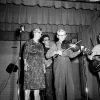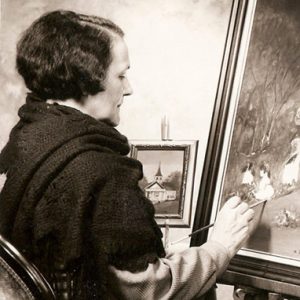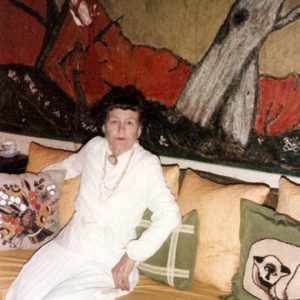calsfoundation@cals.org
Helen Long Bittick (1918–1985)
Helen Marie Long Bittick was an artist of the “primitive folk style,” meaning that she had no academic art training but developed her own unschooled, unique patterns of portraying her subjects.
Helen Long was born on June 24, 1918, to Bette Ann Mangum and William Monroe Long on the Judge Level Farm between Washington (Hempstead County) and Hope (Hempstead County); she had three siblings. Her father ran a restaurant in Hope and farmed in McCaskill (Hempstead County). Long attended Brookwood School in Hope, the three-room schoolhouse in Friendship, and schools in McCaskill and Blevins (all in Hempstead County). She did not graduate from high school.
She married Cloid Sykes Bittick on November 12, 1933, in Bingen (Hempstead County). They had three children, one of whom lived to adulthood.
For Christmas of 1944, Bittick’s husband gave her a set of oil paints and an easel, thus inspiring her to pursue art. From then until her death, Bittick focused her art on the preservation of the images—the personal, community, historical, and spiritual blend—that surrounded her. Her paintings of women in hats, Arkansas flowers, and family gatherings exhibited local favor; her entries in regional art exhibitions gained her wider attention. Her paintings of sixty original rural churches were exhibited at Historic Washington State Park from 1975 to 1984 and were donated to the First United Methodist Church in El Dorado (Union County) on November 11, 1984. These paintings remain on exhibit at the church and have been exhibited twice at the South Arkansas Arts Center in El Dorado. Her painting Baptism at Bluff Church in Hog Scald Hollow was included in the exhibition “American Folk Art from the Ozarks to the Rockies” at the Oklahoma Art Center, the Springfield Art Museum in Missouri, and the Arkansas Arts Center (now the Arkansas Museum of Fine Arts) in Little Rock (Pulaski County) in 1975.
Bittick’s Typhoid Fever Shots and Box Supper 1928 was chosen as the illustration for the invitation to her “Country Church” exhibition at the El Dorado church in November 1984. This work is central to her folk art style: a church surrounded by houses and mercantile establishments, families in line for shots and food, trees and a chugging train in background. The Night the Stars Fell is Bittick’s portrayal of members of the Bethel Baptist Church in Pike County kneeling on the ground in a prayerful acceptance of the unknown as stars streaked across the sky. Her painting Goff Chapel depicts African-American women and children entering the Hempstead County church in sparkling white dresses while the well-dressed men admire a 1930s automobile. For Whom the Bell Tolls shows oversized men approaching the detached bell tower beside the Columbus Baptist Church in Hempstead County. The Preacher was a Bachelor shows a line of women hurriedly entering Texarkana First Methodist Church in 1905.
Bittick exhibited her love of community life in her depiction of country churches that would soon be replaced by more modern architecture or lost as the rural population moved to town. Her oversized wagons, off-kilter church windows and doors, and boldly colored portraits were only part of her creative endeavors. On large wood panels, she arranged nails, rocks, and paint to depict tigers, plants, and flowers. She also used seeds and pebbles to construct murals on walls, hammered steel patterns, painted on glass, hand-pieced magnificent quilts, arranged dried feathers and flowers, crocheted children’s clothes and tablecloths, and inlaid tile designs for tables and bathroom cabinets.
Bittick’s work has been shown multiple times in El Dorado, Texarkana (Miller County), Hope, Nashville (Howard County), Camden (Ouachita County), Lockesburg (Sevier County), and the War Eagle Fair in northwestern Arkansas. She taught art to all ages at her studio in McCaskill in the 1970s before moving to Washington in 1979. Her work is in many private collections.
Bittick died on July 15, 1985, after suffering physical disabilities and arthritis. She is buried in Old Washington Cemetery. In addition to being an artist, she was also a Daughter of the American Revolution and a Daughter of Texas.
For additional information:
“Painting Church Life.” Arkansas United Methodist. December 21, 1984, pp. 6–7.
“Showing in the Gallery for April—‘Amen.’” South Arkansas Arts Center Newsletter, April 2007, p. 1.
Woods, Betty. “Today’s Women—They Live in the Past and the Present.” Arkansas Democrat. April 13, 1975, p. 1C.
M. Ann Bittick
Southern Arkansas University
 Arts, Culture, and Entertainment
Arts, Culture, and Entertainment Divergent Prosperity and the Arc of Reform, 1968–2022
Divergent Prosperity and the Arc of Reform, 1968–2022 Folklore and Folklife
Folklore and Folklife Helen Long Bittick
Helen Long Bittick  Helen Long Bittick
Helen Long Bittick 



Comments
No comments on this entry yet.